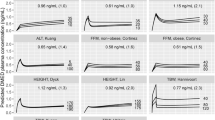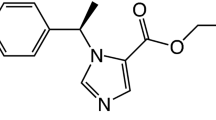Summary
-
1.
Intravenous administration of clonidine hydrochloride (3–100μg/kg) produced a dose-dependent pupillary dilation in anaesthetized rats. All experiments were carried out in rats in which vagosympathetic nerve trunks were sectioned bilaterally at the cervical level.
-
2.
Clonidine-induced mydriasis was present only in those preparations having intact parasympathetic neural tone to the iris.
-
3.
Depletion of CNS monoamines by more than 95% with reserpine (5mg/kg) and alpha-methyl-para-tyrosine (2×300mg/kg) failed to alter the dose-response relation to clonidine.
-
4.
Pretreatment with the alpha-2-adrenoceptor antagonist, yohimbine hydrochloride (1.5 mg/kg), produced about a 10-fold shift to the right in the pupillary dose-response curve to clonidine. Yohimbine administered after the highest dose of clonidine also antagonized the mydriatic response.
-
5.
The above results suggest that clonidine acts on CNS post-synaptic alpha-2-adrenoceptors to produce mydriasis by withdrawal of parasympathetic neural tone to the iris.
-
6.
In an attempt to assess the physiological substrate(s) involved, mydriatic responses, due to parasympatho-inhibition, were evoked by electrial stimulation of ascending (sciatic nerve and medullary) and descending (hypothalamic) pathways.
-
7.
Yohimbine (0.3 and 1.0mg/kg) produced a dose-dependent inhibition of the pupillary dilation evoked by stimulation of the sciatic nerve and medullary loci, whereas these doses of yohimbine failed to alter the dilation in response to hypothalamic stimulation.
-
8.
Similarly, monoamine depletion greatly antagonized the pupillary dilation elicited by sciatic nerve and medullary stimulation without significantly affecting mydriasis due to hypothalamic stimulation.
-
8.
These results suggest that pupillary dilation produced by activation of ascending inhibitory mechanisms may utilize a monoamine as an inhibitory neurotransmitter (perhaps noradrenaline) and that inhibition descending from the hypothalamus is not monoaminergic. It is further speculated that clonidine may produce mydriasis in this species by activation of CNS post-synaptic alpha-2-adrenoceptors (perhaps on neurons of the Edinger-Westphal nucleus) which normally subserve tonic inhibition arising from the periphery.
Similar content being viewed by others
References
Baum T, Shropshire AT (1977) Susceptibility of spontaneous sympathetic outflow and sympathetic reflexes to depression by clonidine. Eur J Pharmacol 44:121–129
Berridge TL, Gadie B, Roach AG, Tulloch (1983) α2-Adrenoceptor agonists induce mydriasis in the rat by an action within the central nervous system. Br J Pharmacol 78:507–515
Bogdanski DF, Sulser F, Brodie BB (1961) Comparative action of reserpine, tetrabenazine and chlorpromazine on central parasympathetic activity: effects on pupillary size and lacrimation in rabbit and on salivation in dog. J Pharmacol Exp Therap 132:176–182
Coote JH, Macleod VH (1974) The influence of bulbospinal monoaminergic pathways on sympathetic nerve activity. J Physiol (Lond) 241:453–475
Coote JH, Macleod VH, Fleetwood-Walker S, Gilbey MP (1981) The response of individual sympathetic preganglionic neurones to microelectrophoretically applied endogenous monoamines. Brain Res 215:135–145
Dahlström A, Fuxe K, Hillarp N-A, Malmfors T (1964) Adrenergic mechanisms in the pupillary light-reflex path. Acta Physiol Scand 62:119–124
De Groat WC, Ryall RW (1967) An excitatory action of 5-hydroxytryptamine on sympathetic preganglionic neurones. Exp Brain Res 3:299–305
Dembowsky K, Czachurski J, Amendt K, Seller H (1980) Tonic descending inhibition of the spinal somato-sympathetic reflex from the lower brain stem. J Auton Nerv Syst 2:157–182
Franz DN, Madsen PW (1982) Differential sensitivity of four central sympathetic pathways to depression by clonidine. Eur J Pharmacol 78:53–59
Gherezghiher T, Koss MC (1979) Clonidine mydriasis in the rat. Eur J Pharmacol 57:263–266
Gherezghiher T, Christensen HD, Koss MC (1982) Studies on the mechanism of methyl-dopa-induced mydriasis in the cat. Naunyn-Schmiedeberg's Arch Pharmacol 320:58–62
Gherezghiher T, Koss MC, Christensen HD (1983) Alpha-methyl-DOPA-induced mydriasis in the cat. Relationship between pupillary response and the oculomotor perfusate concentration of methyldopa and its metabolites. Naunyn-Schmiedeberg's Arch Pharmacol 324:201–206
Guyenet PG, Cabot JB (1981) Inhibition of sympathetic preganglionic neurons by catecholamines and clonidine: mediation by an alpha-adrenergic receptor. J Neurosci 1:908–917
Haeusler G (1974) Clonidine-induced inhibition of sympathetic activity: No indication for a central presynaptic or an indirect sympathomimetic mode of action. Naunyn-Schmiedeberg's Arch Pharmacol 286:97–111
Hamel EG, Jr, Kaelber WW (1961) Reserpine action on the central nervous system of the cat. Am J Physiol 200:195–200
Hodes R (1940) The efferent pathway for reflex pupillo-motor activity. Am J Physiol 131:144–155
Koss MC (1979a) Clomdine mydriasis in the cat: further evidence for a CNS postsynaptic action. Naunyn-Schmiedeberg's Arch Pharmacol 309:235–239
Koss MC (1979b) Topical clonidine produces mydriasis by a central nervous system action. Eur J Pharmacol 55:305–310
Koss MC (1980a) Studies on the mechanism of amphetamine mydriasis in the cat. J Pharmacol Exp Therap 213:49–53
Koss MC (1980b) Methyldopa produces central inhibition of parasympathetic activity in the cat. Naunyn-Schmiedeberg's Arch Pharmacol 314:135–139
Koss MC (1981) Analysis of pupillary dilation produced by analogs of clonidine. Eur J Pharmacol 74:303–309
Koss MC, Christensen HD (1979) Evidence for a central postsynaptic action of clonidine. Naunyn-Schmiedeberg's Arch Pharmacol 307:45–50
Koss MC, San LC (1976) Analysis of clonidine-induced mydriasis. Invest Ophthal 15:566–570
Koss MC, Gherezghiher T, Nomura N (1984) CNS adrenergic inhibition of parasympathetic oculomotor tone. J Auton Nerv Syst 10:55–68
Parsons JH (1901) On dilatation of the pupil from stimulation of the cortex cerebri. J Physiol (Lond) 25:366–379
Pellegrino LJ, Pellegrino AS, Cushman AJ (1979) A stereotaxic atlas of the rat brain. 2. edn. Plenum Press, New York
Sigg EB, Sigg TD (1967( Adrenergic modulation of central function. In: Garattini S, Dukes MNG (eds) Antidepressant drugs. Excerpta Med Foundation, pp 172–178
Sigg EB, Sigg TD (1973) The modification of the pupillary light reflex by chlorpromazine, diazepam and pentobarbital. Brain Res 50:77–86
Ury B, Gellhorn E (1939) Role of the sympathetic system in reflex dilatation of pupil. J Neurophysiol 2:268–275
Weinstein EA, Bender MB (1941) Pupillodilator reactions to sciatic and diencephalic stimulation: a comparative study in cat and monkey. J Neurophysiol 4:44–50
Whishaw IQ, Cioe JDD, Previsich N, Kolb B (1977) The variability of the interaural line vs the stability of bregma in rat stereotaxic surgery. Physiol Behav 19:719–722
Yonkman FF, Stilwell D, Jeremias R (1944) The adrenolytic and sympatholytic actions of yohimbine and ethyl yohimbine. J Pharmacol Exp Ther 81:111–115
Author information
Authors and Affiliations
Rights and permissions
About this article
Cite this article
Hey, J.A., Gherezghiner, T. & Koss, M.C. Studies on the mechanism of clonidine-induced mydriasis in the rat. Naunyn-Schmiedeberg's Arch. Pharmacol. 328, 258–263 (1985). https://doi.org/10.1007/BF00515551
Received:
Accepted:
Issue Date:
DOI: https://doi.org/10.1007/BF00515551




